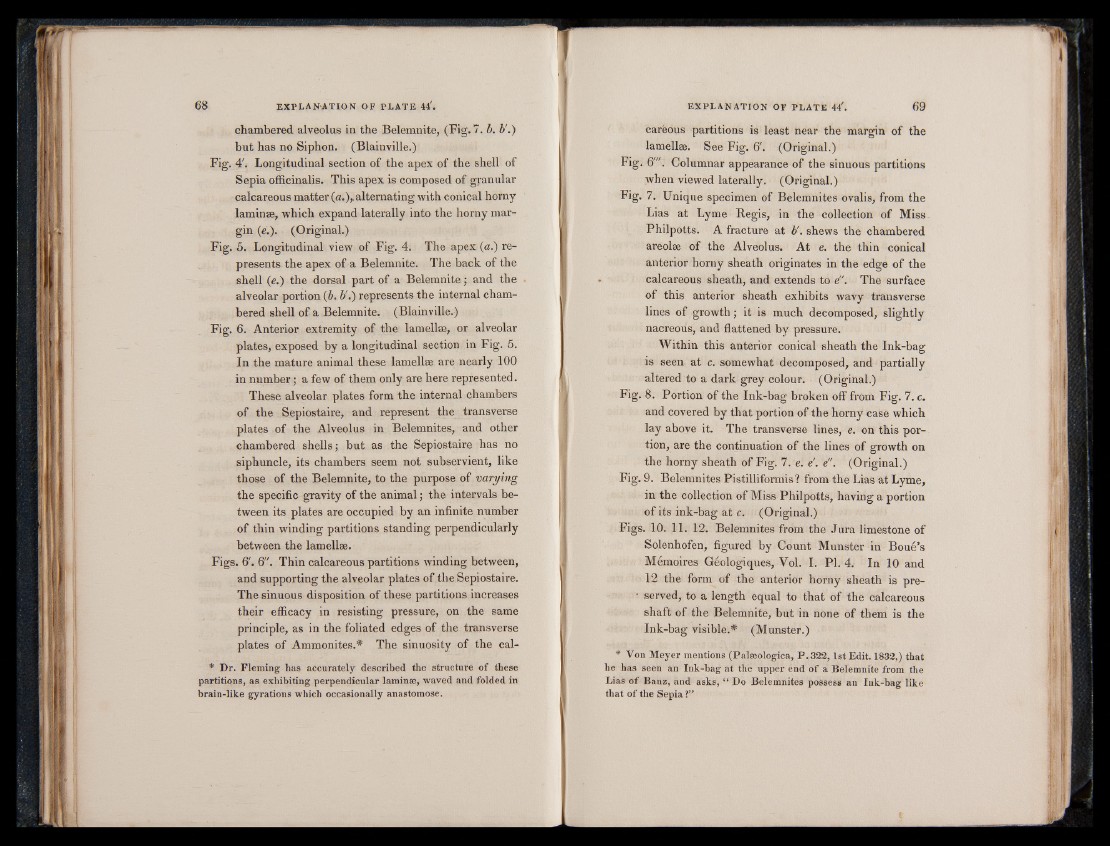
chambered alveolus in the Belemnite, (Fig. 7. b. b'.)
but has no Siphon. (Blainville.)
Fig. 4'. Longitudinal section of the apex of the shell of
Sepia officinalis. This apex is composed of granular
calcareous matter (a.),.alternating with conical homy
laminae, which expand laterally into the horny margin
(e.). (Original.)
Fig. 6. Longitudinal view of Fig. 4. The apex (a.) represents
the apex of a Belemnite. The back of the
shell (e.) the dorsal part of a Belemnite; and the
alveolar portion (b. b'.) represents the internal chambered
shell of a Belemnite. (Blainville.)
Fig. 6. Anterior extremity of the lamellae, or alveolar
plates, exposed by a longitudinal section in Fig. 5.
In the mature animal these lamellae are nearly 100
in number; a few of them only are here represented.
These alveolar plates form the internal chambers
of the Sepiostaire, and represent the transverse
plates of the Alveolus in Belemnites, and other
chambered shells; but as the Sepiostaire has no
siphuncle, its chambers seem not subservient, like
those of the Belemnite, to the purpose of varying
the specific gravity of the animal; the intervals between
its plates are occupied by an infinite number
of thin winding partitions standing perpendicularly
between the lamellse.
Figs. 6'. 6". Thin calcareous partitions winding between,
and supporting the alveolar plates of the Sepiostaire.
The sinuous disposition of these partitions increases
their efficacy in resisting pressure, on the same
principle, as in the foliated edges of the transverse
plates of Ammonites.* The sinuosity of the cal-
* Dr. Fleming has accurately described the structure of these
partitions, as exhibiting perpendicular laminae, waved and folded in
brain-like gyrations which occasionally anastomose.
car'eous partitions is least near the margin of the
lamellæ. See Fig. 6'. (Original.)
Fig. 6'". Columnar appearance of the sinuous partitions
when viewed laterally. (Original.)
Fig. 7. Unique specimen of Belemnites ovalis, from the
Lias at Lyme Regis, in the collection of Miss
Philpotts. A fracture at V. shews the chambered
areolæ of the Alveolus. At e. the thin conical
anterior horny sheath originates in the edge of the
calcareous sheath, and extends to e". The surface
of this anterior sheath exhibits wavy transverse
lines of growth ; it is much decomposed, slightly
nacreous, and flattened by pressure.
Within this anterior conical sheath the Ink-bag
is seen at c. somewhat decomposed, and partially
altered to a dark grey colour. (Original.)
Fig. 8. Portion of the Ink-bag broken off from Fig. 7. c.
and covered by that portion of the horny case which
lay above it. The transverse lines, e. on this portion,
are the continuation of the lines of growth on
the horny sheath of Fig. 7. e. e. e". (Original.)
Fig. 9. Belemnites Pistilliformis ? from the Lias at Lyme,
in the collection of Miss Philpotts, having a portion
of its ink-bag at c. (Original.)
Figs. 10. 11. 12. Belemnites from the Jura limestone of
Solenhofen, figured by Count Munster in Boué’s
Mémoires Géologiques, Vol. I. PI. 4. In 10 and
12 the form of the anterior horny sheath is pre-
• served, to a length equal to that of the calcareous
shaft of the Belemnite, but in none of them is the
Ink-bag visible.* (Munster.)
* Von Meyer mentions (Palæologica, P .3 2 2 ,1st Edit. 1832,) that
he has seen an Ink-bag at the upper end of a Belemnite from the
Lias of Banz, and asks, “ Do Belemnites possess an Ink-bag like
that of the Sepia ?”